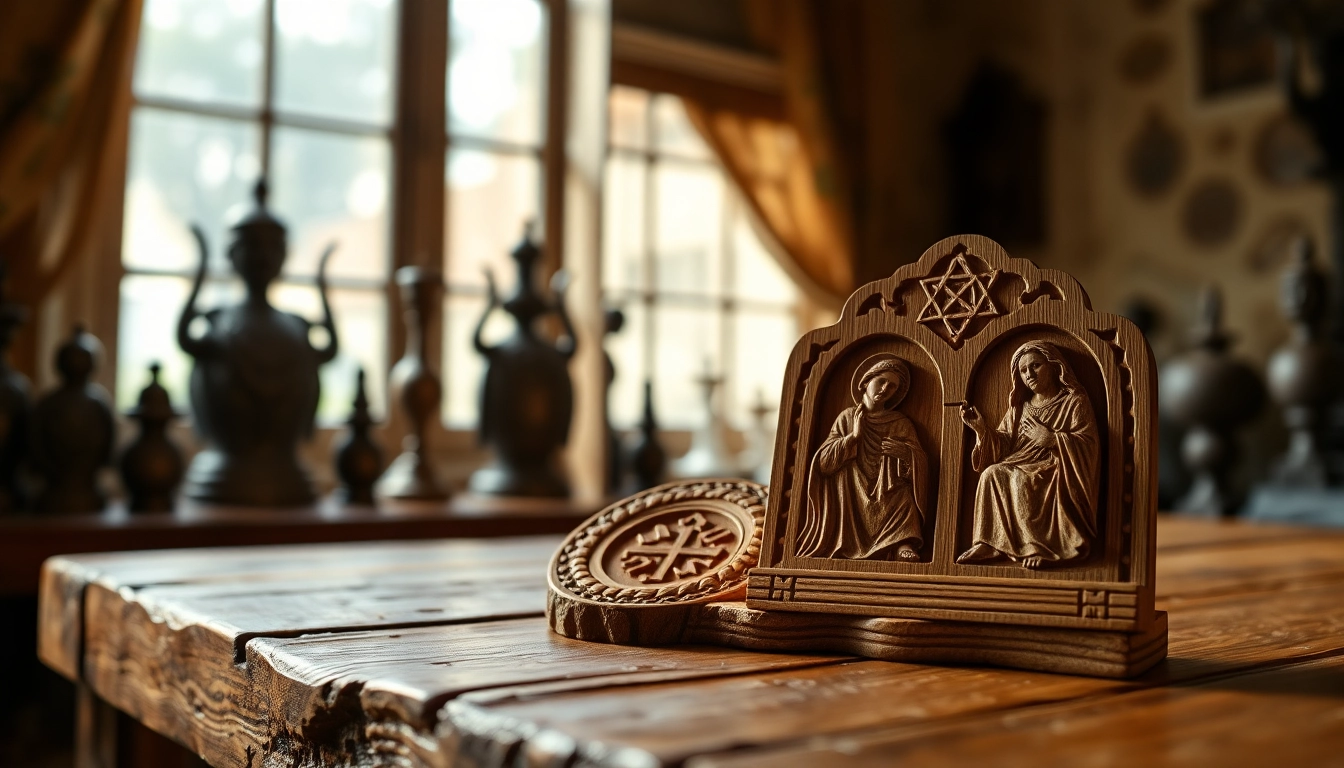Introduction to Olive Wood Carvings
Olive wood carvings embody a rich tradition of artistry that stretches back through centuries of history and cultural significance. Carved masterfully from the resilient and beautiful wood of the olive tree, these creations represent not only craftsmanship but also a deep connection to spirituality and heritage. For those desiring to explore these exquisite works of art further, Olive wood carvings serve as an embodiment of faith and culture, cherished both as decorative pieces and spiritual artifacts.
What are Olive Wood Carvings?
Olive wood carvings are artistic representations or functional items that are crafted from the wood of the olive tree, which is known for its durability, intricate grain, and warm hues. Artisans skillfully carve various objects, including religious figures, decorative pieces, and everyday items that reflect their intricate craftsmanship and deep cultural roots. The use of olive wood is especially prevalent in the Holy Land, where local artisans continue a long-standing tradition of wood carving.
Historical Significance of Olive Wood Carvings
The history of olive wood carving is intertwined with the agricultural practices of ancient civilizations. The cultivation of olive trees dates back thousands of years, particularly in regions such as the Mediterranean and the Middle East. Historically, olive wood was highly valued not only for its beauty and durability but also for its spiritual symbolism. In Christian faith, the olive tree is a symbol of peace, life, and endurance, which has led to the carving of significant artistic representations, especially since olive wood is often seen in religious contexts, such as nativity scenes or crosses.
Overview of Carving Techniques
Olive wood carving employs various techniques that are passed down through generations. Artisans often utilize traditional tools such as chisels, knives, and gouges to intricately shape the wood, creating stunning designs and details. The natural grain of the wood enhances the carving, allowing each piece to tell its unique story. Techniques such as relief carving and in-the-round sculpting are commonly used, showcasing the artisans’ skills and creativity.
The Artistry Behind Olive Wood Carvings
Hand-Carving vs. Machine Production
While machine production has its advantages, hand-carving remains the preferred method among skilled artisans. Hand-carved pieces often reflect subtle imperfections and unique characteristics that machines cannot replicate, contributing to the authenticity and charm of the final product. The human touch imbues each carving with a narrative that resonates with both the maker and the consumer, resulting in a connection that is both artistic and emotional.
Tools and Materials Used in Olive Wood Carvings
The primary material for these carvings is, of course, olive wood, which is favored for its density, fine grain, and pleasant aroma. Carving tools vary, including various types of knives, gouges, and chisels tailored for intricate designs. Some artisans might use sanding tools to refine the finish, ensuring that the piece captures the natural beauty of the wood while providing a smooth surface. In addition, the use of protective oils may be employed to enhance the wood’s luster and longevity.
Profiles of Artisans and Their Craft
Artisans who specialize in olive wood carvings often come from generations of woodworkers, learning their craft from family members and honing their skills over the years. Each artisan infuses their cultural background and personal experiences into their work, which can vary significantly based on local traditions and techniques. Through interviews and biographies, one can discover the dedication and passion that goes into each carving, making them not only products but also stories waiting to be shared.
Spiritual and Cultural Aspects of Olive Wood Carvings
Religious Symbolism in Olive Wood Carvings
In many faiths, olive wood holds profound religious significance. Christian iconography often incorporates olive wood carvings in the form of nativities, crosses, and saints, accentuating the spiritual dimension of these artifacts. As the olive tree symbolizes peace and resilience, its carvings serve not only as decorative objects but also as reminders of faith, hope, and spirituality. They play a pivotal role in religious practices and ceremonies, enhancing the nurturing connection between believers and their faith.
Cultural Heritage and Preservation
Olive wood carving is more than an art form; it is a means of preserving cultural identity. In regions where olive wood carving is practiced, these artisans often face pressures from modernization and globalization that threaten traditional techniques. Many artists are committed to preserving this intricate craft, teaching the younger generation the importance of their heritage. Supporting local artisans through intentional purchases directly contributes to the conservation of these age-old practices.
The Role of Olive Wood Carvings in Celebrations and Rituals
Olive wood carvings often find their place in celebrations and rituals, especially within Christian communities. During major holidays like Christmas and Easter, handcrafted nativity sets or cross carvings become focal points of spiritual reflection and joy. These pieces not only enhance the festive atmosphere but also serve as tangible reminders of significant religious stories and events, deeply enriching the cultural fabric of such occasions.
Choosing the Right Olive Wood Carving for You
Factors to Consider When Buying Olive Wood Carvings
When selecting an olive wood carving, potential buyers should consider a few factors. Firstly, the quality of the wood itself is crucial—durability and aesthetic appeal should align with personal preferences. Additionally, the craftsmanship is a key indicator of quality; examining the detail and finish of the carving will reveal the skill and care of its creator. Understanding the significance of the piece, whether for personal enjoyment or as a spiritual symbol, can also help guide the choice.
How to Authenticate Olive Wood Carvings
Authenticity is vital when purchasing olive wood carvings, particularly to ensure that you are investing in genuine pieces. Buyers should seek certifications or documentation from artisans or sellers that confirm the origin and craftsmanship of the carvings. Furthermore, reviewing the seller’s reputation or customer feedback can provide insights into the reliability and authenticity of their products. Understanding the local culture and craftsmanship can also aid in discerning genuine pieces from mass-produced imitations.
Caring for Your Olive Wood Carvings
To maintain the beauty and integrity of olive wood carvings, proper care is essential. Regular dusting with a soft cloth will help prevent dirt buildup. If the piece appears dry, applying a food-safe mineral oil can help preserve its luster and grain. Avoid exposing the carvings to direct sunlight or high humidity, which can cause damage over time. With proper care, olive wood carvings can last for generations, retaining their character and beauty.
The Market for Olive Wood Carvings
Where to Find Authentic Olive Wood Carvings
Authentic olive wood carvings are primarily found in regions where the artisans practice their craft, notably in the Holy Land. Many local artisans sell their work at fairs, religious sites, and artisan shops. Additionally, online marketplaces that specialize in handcrafted goods often offer a selection of olive wood carvings. Buyers should ensure they are purchasing directly from artisans or trusted galleries to guarantee the authenticity of their chosen pieces.
Trends in the Olive Wood Carving Market
In recent years, there has been a growing trend toward sustainable and ethically sourced products, significantly influencing the olive wood carving market. As consumers become more conscious of their purchasing decisions, the demand for authentic, handmade products has surged. Additionally, online shopping has opened new avenues for artisans, allowing their creations to reach a global audience, which elevates the appreciation for this traditional craft.
Supporting Local Artisans and Communities Through Purchases
Purchasing olive wood carvings is more than just acquiring a decorative piece; it is an investment in heritage and local communities. Engaging directly with artisans empowers their craft and supports their livelihoods. By opting for handmade goods over mass-produced alternatives, consumers can help sustain this artistry, ensuring the skills and traditions of olive wood carving continue to thrive for future generations.















Leave a Reply